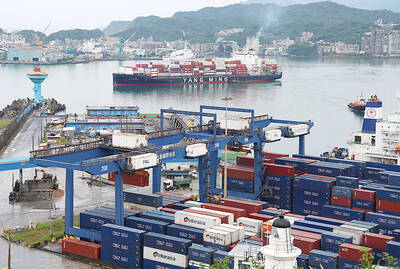The Fair Trade Commission yesterday approved MediaTek Inc’s (聯發科) application to acquire local rival MStar Semiconductor Inc (晨星半導體), saying the merger would not hamper market competition.
That will pave the way for MediaTek, the nation’s No. 1 handset chip designer, to complete its first-stage acquisition of the world’s top TV chip supplier later this month, by taking up a 48 percent stake in MStar. The mobile phone chipmaker will start including about half of MStar’s monthly revenue into its revenue next month, MediaTek told investors on Tuesday.
MediaTek plans to fully acquire MStar for NT$115 billion (US$3.83 billion) in a cash-and-share offer by the first quarter of next year.
“As the companies involved in this case export a massive portion of their products overseas, it is difficult to say the combination will significantly boost the new entity’s ability to increase product prices as they are facing competition from bigger global rivals,” the commission said in a statement yesterday.
Besides, the merger would not make it any easier for the new entity to take joint actions with its rivals to prevent new players from entering the market, the commission said.
The merger “will help enhance the country’s overall competitiveness in TV controller chips to compete with global rivals,” the commission said.
“The merger will create bigger business interests rather than the adverse impact of hampering competition,” it said.
The share price of MediaTek rose 6.86 percent to NT$272.50 yesterday after the chip company on Tuesday issued a stronger-than-expected revenue and gross margin forecast for this quarter.
Gross margin would improve to between 41 percent and 43 percent in the current quarter, compared with 40.8 percent last quarter, on expectations that shipments of higher-margin smartphone chips would outpace those of feature phone chips and become the company’s biggest revenue source.
Higher-margin 3G smartphone chips would account for a bigger share, or 60 percent of overall smartphone chip shipments this quarter, from 30 percent last quarter, MediaTek said.
The gross margin forecast was higher than the 40 percent projected by Barclays analyst Andrew Lu (陸行之), who said in a note on Tuesday that it would be the first improvement following quarter-on-quarter declines over the past 10 quarters.
MediaTek said its revenue would expand between 13 percent and 18 percent sequentially to between NT$26.5 billion and NT$27.7 billion this quarter, beating Lu’s expectation of 11 percent growth.
Lu added MediaTek to his top pick list because of the strong guidance, with the target price unchanged at NT$340, and retained his “overweight’ rating on the chipmaker.
MediaTek expected as much as one-third of its revenues this quarter would come from selling smartphone chips, citing robust demand for its low and medium-end smartphone chips after Chinese telecoms operators began promoting smartphones with a cheaper price tag of 600 yuan (US$94) per unit.
Strong demand prompted MediaTek to raise its smartphone chip shipment forecast again to 95 million units this year from its previous estimate of 75 million units.

CHIP RACE: Three years of overbroad export controls drove foreign competitors to pursue their own AI chips, and ‘cost US taxpayers billions of dollars,’ Nvidia said China has figured out the US strategy for allowing it to buy Nvidia Corp’s H200s and is rejecting the artificial intelligence (AI) chip in favor of domestically developed semiconductors, White House AI adviser David Sacks said, citing news reports. US President Donald Trump on Monday said that he would allow shipments of Nvidia’s H200 chips to China, part of an administration effort backed by Sacks to challenge Chinese tech champions such as Huawei Technologies Co (華為) by bringing US competition to their home market. On Friday, Sacks signaled that he was uncertain about whether that approach would work. “They’re rejecting our chips,” Sacks

NATIONAL SECURITY: Intel’s testing of ACM tools despite US government control ‘highlights egregious gaps in US technology protection policies,’ a former official said Chipmaker Intel Corp has tested chipmaking tools this year from a toolmaker with deep roots in China and two overseas units that were targeted by US sanctions, according to two sources with direct knowledge of the matter. Intel, which fended off calls for its CEO’s resignation from US President Donald Trump in August over his alleged ties to China, got the tools from ACM Research Inc, a Fremont, California-based producer of chipmaking equipment. Two of ACM’s units, based in Shanghai and South Korea, were among a number of firms barred last year from receiving US technology over claims they have

Taiwan’s exports soared 56 percent year-on-year to an all-time high of US$64.05 billion last month, propelled by surging global demand for artificial intelligence (AI), high-performance computing and cloud service infrastructure, the Ministry of Finance said yesterday. Department of Statistics Director-General Beatrice Tsai (蔡美娜) called the figure an unexpected upside surprise, citing a wave of technology orders from overseas customers alongside the usual year-end shopping season for technology products. Growth is likely to remain strong this month, she said, projecting a 40 percent to 45 percent expansion on an annual basis. The outperformance could prompt the Directorate-General of Budget, Accounting and

BARRIERS: Gudeng’s chairman said it was unlikely that the US could replicate Taiwan’s science parks in Arizona, given its strict immigration policies and cultural differences Gudeng Precision Industrial Co (家登), which supplies wafer pods to the world’s major semiconductor firms, yesterday said it is in no rush to set up production in the US due to high costs. The company supplies its customers through a warehouse in Arizona jointly operated by TSS Holdings Ltd (德鑫控股), a joint holding of Gudeng and 17 Taiwanese firms in the semiconductor supply chain, including specialty plastic compounds producer Nytex Composites Co (耐特) and automated material handling system supplier Symtek Automation Asia Co (迅得). While the company has long been exploring the feasibility of setting up production in the US to address